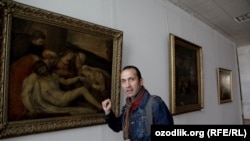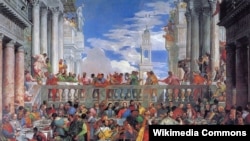Uzbek officials say a canvas on display at a Tashkent museum was painted by prominent Italian Renaissance artist Paolo Veronese. But mystery and doubt surround the recently discovered painting and its author.
Uzbeks are enjoying the chance to gaze at a newly discovered painting by a Renaissance master -- at least that's how the State Fine Arts Museum in Tashkent is describing the surprise addition to its collection.
Whether the artwork is a bona fide piece by the Venetian painter Paolo Veronese is obscured by layers of unvarnished mystery.
Uzbek media quoted officials as announcing last week that "The Mourning of Christ," which is currently on display at the museum, was hidden under another work and had been discovered only recently.
Details regarding the find are sketchy, and important questions remain unanswered, including: Where did the painting come from? How did it end up in an Uzbek museum? How was it lost for so many years and on what basis has it been identified as a Veronese?
The painter -- also known by his given name Paolo Caliari, or Cagliari -- was born in 1528 in Verona, the city from which he took the name "Veronese."
He was a key painter in 16th-century Venice alongside Titian and Tintoretto.
"The Marriage at Cana" and "The Feast of Levi" are among his best-known works.
The museum's curator, Mirfaiz Usmonov, revealed little in an interview with RFE/RL's Uzbek Service, saying only that the Veronese was discovered in the course of a restoration and that it was in very good shape.
Damir Ruziboev, the museum's director between 1987 and 1992, does not discount the possibility, noting he was aware of rumors that a Veronese was held in the museum's depository.
But based on a photograph taken of the painting, the curator of European paintings at the Metropolitan Museum in New York is not so sure.
"From the photograph I have, it's not a painting that is known and to me it looks like it doesn't have much to do with Veronese," Xavier Salomon says. "It's probably a Venetian picture -- I would say -- it could be from the late 16th or early 17th century. But I don't see it as looking particularly like Veronese himself."
'A Nesting Doll'
According to the press secretary of the Uzbek Sports and Culture Ministry, Khindol Madrakhimov, the painting belonged to the family of Russia's last emperor, Nicholas II.
A Tashkent-based restoration expert, who spoke on condition of anonymity, says it is very likely that "The Mourning of Christ" was painted over in the 1990s so it could be smuggled outside the country.
Calling the technique "matryoshka" -- or nesting doll in Russian -- the expert says it was used on many occasions to smuggle very valuable paintings out of the country after Uzbekistan gained independence in 1991.
At the end of 2001, a number of valuable paintings by Russian artists, including Ivan Aivazovsky, Vasily Tropinin, Karl Bryllov, and Vasily Surikov, were stolen from the State Fine Arts Museum.
The announcement of the discovery of "The Mourning of Christ" comes as a collection of ceramics made by Pablo Picasso, which has not been seen in public for around four decades, has gone on display at the museum.
The 12 ceramics had reportedly been exhibited in Tashkent in the 1960s, but were subsequently forgotten in storage until their rediscovery in 2004.
Uzbeks are enjoying the chance to gaze at a newly discovered painting by a Renaissance master -- at least that's how the State Fine Arts Museum in Tashkent is describing the surprise addition to its collection.
Whether the artwork is a bona fide piece by the Venetian painter Paolo Veronese is obscured by layers of unvarnished mystery.
Uzbek media quoted officials as announcing last week that "The Mourning of Christ," which is currently on display at the museum, was hidden under another work and had been discovered only recently.
Details regarding the find are sketchy, and important questions remain unanswered, including: Where did the painting come from? How did it end up in an Uzbek museum? How was it lost for so many years and on what basis has it been identified as a Veronese?
The painter -- also known by his given name Paolo Caliari, or Cagliari -- was born in 1528 in Verona, the city from which he took the name "Veronese."
He was a key painter in 16th-century Venice alongside Titian and Tintoretto.
"The Marriage at Cana" and "The Feast of Levi" are among his best-known works.
The museum's curator, Mirfaiz Usmonov, revealed little in an interview with RFE/RL's Uzbek Service, saying only that the Veronese was discovered in the course of a restoration and that it was in very good shape.
Damir Ruziboev, the museum's director between 1987 and 1992, does not discount the possibility, noting he was aware of rumors that a Veronese was held in the museum's depository.
But based on a photograph taken of the painting, the curator of European paintings at the Metropolitan Museum in New York is not so sure.
"From the photograph I have, it's not a painting that is known and to me it looks like it doesn't have much to do with Veronese," Xavier Salomon says. "It's probably a Venetian picture -- I would say -- it could be from the late 16th or early 17th century. But I don't see it as looking particularly like Veronese himself."
'A Nesting Doll'
According to the press secretary of the Uzbek Sports and Culture Ministry, Khindol Madrakhimov, the painting belonged to the family of Russia's last emperor, Nicholas II.
A Tashkent-based restoration expert, who spoke on condition of anonymity, says it is very likely that "The Mourning of Christ" was painted over in the 1990s so it could be smuggled outside the country.
Calling the technique "matryoshka" -- or nesting doll in Russian -- the expert says it was used on many occasions to smuggle very valuable paintings out of the country after Uzbekistan gained independence in 1991.
At the end of 2001, a number of valuable paintings by Russian artists, including Ivan Aivazovsky, Vasily Tropinin, Karl Bryllov, and Vasily Surikov, were stolen from the State Fine Arts Museum.
The announcement of the discovery of "The Mourning of Christ" comes as a collection of ceramics made by Pablo Picasso, which has not been seen in public for around four decades, has gone on display at the museum.
The 12 ceramics had reportedly been exhibited in Tashkent in the 1960s, but were subsequently forgotten in storage until their rediscovery in 2004.













